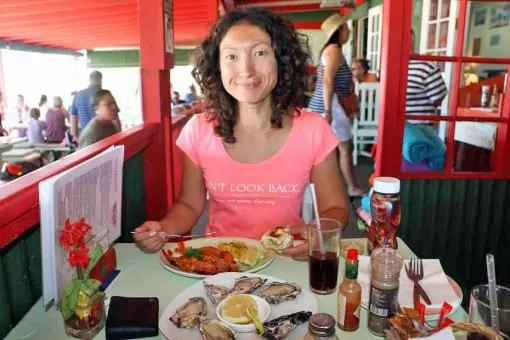Best Towns to Visit on the Portuguese Camino de Santiago

Table of Contents
Walking the Portuguese Camino is a very nice alternative to the popular Camino Frances, with coastal and rural scenery leading to Santiago. The Camino Portuguese is the second most popular Camino de Santiago route to walk with more than 25% of all pilgrims following this way to Santiago de Compostela every year.
This stunning route passes beautiful towns and villages with spectacular views of the scenic countryside and rugged coastline of Portugal and Spain with two UNESCO World Heritage cities on the way. Living in Portugal we have explored this route extensively. Here we highlight some of our favorite places to visit on the Portuguese Way. These are all great stops for a rest day during your pilgrimage.

The Portuguese Camino de Santiago
The Camino de Santiago is a network of pilgrimage routes that start in different places across Europe and finish in Santiago de Compostela, Spain. There are several variations of the Camino Portuguese. The three most popular starting points and walking distances to the cathedral in Santiago de Compostela are Porto, Lisbon (630 km/391 mi), and Tui (124 km/77 mi). There are three different Camino routes starting in Porto. You can follow the Central Route (260 km/161 mi), the Coastal Route (280 km/173 mi) hugging the Atlantic Ocean, or the Litoral Way (280 km/173) mi that crosses from the Central to the Coastal Route. Several of the stunning towns on this Camino route have beautiful sites and amazing histories and cultures to experience. So when you are going to spend some time on the Camino Portugués here are some of our favorite spots between the main road and small villages to enjoy on those rest days.

Porto (Coastal and Central Routes)
Porto is a fantastic city and the most popular starting point for the Portuguese Camino, it is a great place to spend a couple of days before walking the first day. Explore the narrow twisting cobblestone streets climbing up and down the hills lined by authentic Portuguese houses with terracotta tiled roofs. Experience life around the Duoro River by going on a boat cruise in a traditional Rabello boat. Enjoy jaw-dropping views of beautiful medieval buildings on the shores of the Douro River from Miradouro da Vitória at sunset. Walk in the streets of the Ribeira district with its colorful houses, riverfront views, and vibrant cafes and bars. Drink Port in Porto! Visit some of the traditional Port houses and wine houses on the banks of the River Douro to sample some of the country´s most famous exports. Porto is one of our favorite European cities.

Tours and activities in Porto
If Porto is a rest day or if you have a couple of extra days before starting the Camino walk there are many excellent activities and tours around this beautiful city.
Places to Stay in Porto
Barcelos (Central Route)
Barcelos is a beautiful city, originally a Roman settlement that expanded a lot in the 15th century. The famous Portuguese rooster emblem often seen in Portuguese souvenir shops is also called The Barcelos Rooster (Galo de Barcelos) named after a folktale about a pilgrim on his way to Santiago that walks through this town. There are some nice sites to visit in Barcelos such as; Ponte de Barcelos – a 14th-century bridge, the Tower of Barcelos, the church of Senhor da Cruz, and the church Matriz de Barcelos. The city is well-known for its pottery and the famous Rooster of Barcelos can be seen everywhere in town.

Tours and activities in Barcelos
Barcelos, Braga, and Guimarães Tour – Discover three of northern Portugal’s historic cities on this full-day tour.
Places to stay in Barcelos
Ponta de Lima (Central Route)
Often referred to as “most floral town of Portugal” the picturesque Ponte de Lima is the oldest town in Portugal. You will walk into town on the Camino with your fellow pilgrims on a famous 2000-year-old medieval Roman bridge, Ponte Romano, crossing the Lima River. The town is located relatively close to Barcelos, it is significantly smaller and is known as one of the most beautiful small towns in Portugal.
Ponta de Lima has some interesting sights to see; Ponte Romano (The Roman bridge over the Lima River), Old Chain Tower, Matriz church, the Botanical garden Paço do Marques, and the church of Santo Antonio da Torre Velha. There are many nice accommodation options in the town.

Places to stay in Ponte de Lima
Caminha (Coastal Route)
Caminha is a small coastal town on the south bank of the Minho River in the most northern part of Portugal on the border with Spain. The town is located on the Coastal Route of the Portuguese Camino. The stunning Caminha Old Town with its cobblestone walking streets is a pleasure to explore on foot. The Caminha main square surrounded by Gothic houses is a great location to start exploring this popular town.

Some of the highlights not to miss are the Renaissance fountain: Chafariz do Terreiro, and Clock Tower: Torre do Relogio. Switching from the coastal route in Caminha to the central route in Valença/Tui is a popular Camino route on the Portuguese Way. Walking this way on the Camino Portugués you combine the beautiful seaside scenery of the Coastal Camino and the historical towns of the Central Route.
Valença do Minho (Central Route)
The unique town of Valenca is located on the banks of the Minho River, which separates Portugal from Galicia in Spain. The highlight of Valença is the beautiful medieval fortress Fortaleza de Valença, with the old town located behind the fortress walls.

The impressive fortress was built to protect Portugal from invading Spaniards on the other side of the River Minha. The cobblestone streets of the functioning town enclosed by 5 kilometers of defensive walls are fun to explore leading to cathedrals, churches, chapels, and museums. Take some time to look at the impressive walls surrounding Valença do Minho. In the evenings the streets are crazy busy and we had a great time shopping and sitting at a local cafe people watching and listening to buskers play some popular music. Some of the highlights among the narrow stone-paved streets are the old buildings, the churches Igreja de Santo Estevão; Capela Militar do Bom Jesus and Igreja de Santa Maria dos Anjos, and loads of restaurants, cafes, and souvenir shops.
Places to stay in Valença
There are many places to stay in Valença on different budgets including a public albergue.
Tui (Central Route)
On the Spanish side of the river Minho sits the town Tui opposite Valencia de Minho located on the Portuguese side of the river. An iron bridge crossing the river, designed by Eiffel, links the two towns. You can walk or drive between Portugal and Spain over this bridge. The town winds uphill to the impressive hilltop cathedral with Romanesque and Gothic elements.

Prepare to climb some stairs exploring this beautiful old town area. Tui is a popular starting point for the Camino de Santiago for many pilgrims walking the last 100 kilometers to Santiago de Compostela. This is the minimum distance that must be walked on foot by pilgrims to obtain a Compostela for walking the Camino de Santiago and can be done on many different routes. Close to the cathedral, I saw a couple of private albergues and pilgrims enjoying a pilgrim menu at different cafes. There is a little tourist train that runs on the road from Tui that explores both Tui and Valenca and is a fantastic relaxed way to do sightseeing in both towns.
Places to stay in Tui
Vigo (Coastal Route)
Vigo is the largest city in Galicia, Spain. The coastal city has a nice historical center, many seafood restaurants, and bars. The gastronomy of Vigo is best known for seafood, don’t miss the octopus and mussels! If you have time you can stay for two nights here to explore the city, and its beaches, and maybe visit the Cies Islands. These small islands are probably the most popular tourist attraction in Galicia. This national marine-terrestrial park is a beach paradise with crystal-clear water. Vigo has several historical sites worth visiting. Check out Castro de Vigo (the Vigo Castle), and Plaza del a Puerto del Sol, explore the historical center and waterfront promenade, and explore the stone market.

Places to stay in Vigo
Pontevedra (Central and Coastal)
Pontevedra located in the Rias Baixas region of Galecia is a nice city with plenty of restaurants and bars, a beautiful cathedral, and an interesting historic center. The city has a very pedestrian-friendly historic center with plenty of interesting monuments and churches. Exploring the tapas bars on the cobblestone streets is a fun evening. Eating seafood, particularly mussels and octopus is the gastronomic highlight the city is known for. Some sites to visit are the Gothic Santa María la Mayor Basilica, Peregrina Square, Herrería Square, the river Lérez, the Chains Bridge, the Burgo Bridge, the beautiful Church of Sao Domingos, and the Sexto Edificio museum (Galician art). Exploring the Rias Baixas from Pontevedra is a very popular day trip.

Do a Guided Walking Tour of Pontevedra to learn more about the city from a local guide.
Places to stay in Pontevedra
Combarro (Spiritual Variant)
The magical little fishing village, Combarro, just outside Pontevedra is one of the most beautiful villages in Galicia. This small town is located right on the spiritual variant of the Portuguese coastal route of the Way of Saint James. There are no cars in the historic quarter of Combarro with narrow granite-paved pedestrian streets and tourists exploring the streets on foot. Walking in the narrow historic streets lined with stone Galician houses, tiny gardens, stone crosses, and granaries, the casco histórico, or old town is truly something special. Combarro is a great place to enjoy seaside dining, sitting next to the ocean in a restaurant with a variety of seafood readily available here including clams, scallops, pulpo estila feira, and sardines. This is a beautiful place to stay on the Camino. There are several rustic stone houses offering apartments for rent.
All about Staying in Combarro on the Spiritual Variant of the Camino de Santiago.

Places to Stay in Combarro
Beautiful stone houses, good facilities, excellent location
Budget Places
Padron (Central and Coastal)
The small town, Padrón, with great religious and historic significance is located only 22km from Santiago de Compostela. The variante espiritual joins the main Camino here. Padrón is best known for being the origin of the pimientos de Padron (little Padron peppers), its role in the history of the Camino de Santiago, and as the home of two important writers; poet Rosalía de Castro and Nobel Literature Prize winner, Camilo José Cela.

According to the legend of St.James, two disciples arrived in Pardon (then Iria Flavia) with the body of the apostle, from where he was transported to the location of Santiago de Compostela.
Some sites not to miss in town are the church of Santiago (with the Pedron stone), the Carmo monastery and the Carmelite fountain, the house of Rosalia de Castro museum, and the Espolon Promenade. We were impressed by the beautiful square in front of the cathedral with two rows of platano trees framing the square. Gastronomically the town is very well known for the small, tasty, little Padron peppers. A famous dish to experience on the Camino de Santiago.
Places to stay in Padrón
Santiago de Compostela
Santiago de Compostela is the capital of the Galicia region in the northwest of Spain. All the Camino de Santiago pilgrimage routes lead to what is thought to be the burial site of the Biblical apostle St. James within the Catedral de Santiago de Compostela. Thousands of pilgrims from all over Europe walk to Santiago where they will get the final stamp on their pilgrim passport upon successful completion of the pilgrimage. Sitting on Plaza Obradoiro in front of the cathedral and seeing pilgrims arrive at the end of this long walk is an emotional experience. This breathtaking city filled with beautiful old buildings, churches, squares, fountains, and parks is fantastic to explore on foot. Walking on the old Roman roads, enjoying good food and beautiful scenery is a fantastic day in the city. See our detailed guide to the Best Things To Do in Santiago de Compostela.

Highlights of Santiago de Compostela
- The Cathedral is the main attraction of Santiago de Compostela it’s something not to miss. You can do a guided Cathedral and Museum tour to learn more about its history.
- Attend Pilgrims Mass – Maybe you are very lucky and see the Botafumeiro Ceremony, during this ceremony, a massive silver incense burner attached to the ceiling is swung by 6 specially trained monks.
- Go to Muxia and Finisterre, many pilgrims do this beautiful walk to “the end of the world” after finishing their Camino in Santiago de Compostela. – Fisterra, Muxía, Ezaro, Ría de Muros, Pontemaceira & Costa da Morte: full-day tour
- Explore this fascinating city on foot is fantastic in the summer months, the tourist office is very helpful and can give you a map, with a guided tour you won´t miss the highlights of the city – Historical Center Guided Tour with Official Guide
- There are several unique Spanish dishes not to miss when visiting Santiago. On a gastronomic tour with a local guide you will get a taste of what Galicia has to offer.
Places to stay in Santiago de Compostela
Whether you want to sleep on bunk beds or stay in a luxury hotel, we have some good tips after walking 9 different routes to Santiago de Compostela.
See our article for Best Places to Stay in Santiago de Compostela for Pilgrims
Budget | Santiago KM-0 |
Middle price | Hospedería San Martín Pinario | This place is located right next to the Cathedral. There are special rooms for pilgrims at Hospedaría, these rooms are much more basic compared to the standard room and cost less.
High-end | Parador de Santiago – Hostal Reis Catolicos | You can’t find a place to stay closer to the Cathedral and the historical center than this hotel. It’s been an important part of the Camino de Santiago for centuries.
Please follow and like us:

The pretty half of Stingy Nomads, responsible for all our land adventures (hiking, climbing, walking the Camino) and following them write-ups. Alya loves walking since she was a child, she prefers to walk 1000 km with a backpack rather than to do a 10 000 km road trip (actually any road trip). Alya is a big fan of Latin America, the Spanish language, and dancing. Every time we go away she desperately misses our dog Chile.





